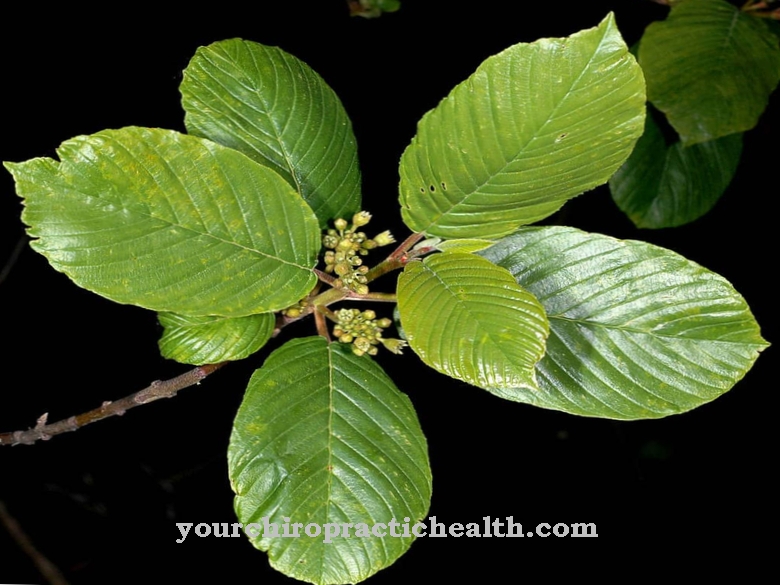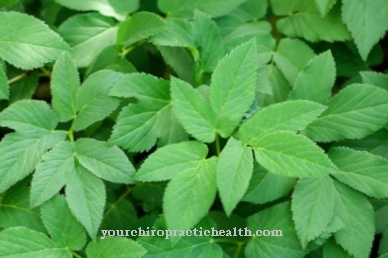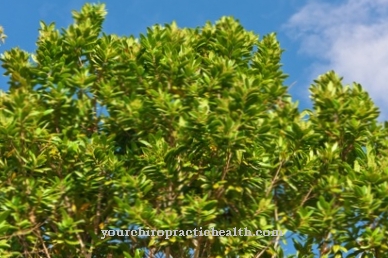Of the Boldo is a shrub whose leaves have numerous uses as medicinal herbs. The antispasmodic and digestive effects of Boldo tea are particularly valued. However, it should be noted that side effects can occur.
Occurrence & cultivation of Boldo

The Boldo needs a dry and warm climate and forms fragrant white or light yellow, bell-shaped flowers, which later become small green or yellow berries. However, only the leaves of Boldo are used for medicinal purposes. These are leathery, rigid and often easily brittle. Their characteristic smell of peppermint or camphor is striking.
In addition, the top of the leaves is covered with numerous light-colored bumps, while the underside is always smooth. For the production of medicines, the leaves on the tree or bush are cut. After drying, they can be shaken off.
Effect & application
In folk medicine in Chile and Peru, the boldo has been a fixture for centuries. It is particularly widely used for various types of abdominal pain and indigestion. These include heartburn, gas, nausea, vomiting, or stomach pain. The Boldo can also be helpful in the case of sluggishness and constipation; the leaves also have a slightly diuretic effect.
The reduced and dried leaves are usually taken in the form of a tea. For a cup of tea, about two teaspoons of the leaves are poured over with boiling water and left for ten minutes. The slightly cooled tea is drunk two to three times a day. Scientific studies underpin the traditional knowledge: The boldo leaves contain alkaloids, flavonoids and two to three percent essential oils as effective ingredients. These stimulate the formation of bile and the production of gastric juice.
That is why Boldo leaves should only be used for stomach and digestive complaints that are characterized by a lack of bile formation or a feeling of fullness. A nervous stomach or irritable bowel syndrome, on the other hand, can be negatively affected by the tea. In Germany, the leaves are already available as a ready-made tea preparation and as a liquid extract.Medicines containing Boldin in solutions or tablets are also available in pharmacies.
The recommended daily dose is around three grams of leaves or 60 drops of liquid extract. The dried leaves are often combined with other medicinal herbs, for example with anise, fennel or peppermint, for nausea and vomiting. Combinations with artichokes and celandine are also proven to stimulate the gallbladder. Due to its digestive stimulating effect, the shrub is also said to support diets. The active ingredients of the leaves are also contained in some weight loss products.
Boldo leaves are also often used as a spice in Latin American cuisine. The slightly bitter, strong aroma gives many traditional Peruvian dishes their characteristic taste. The dried leaves can be used to refine meat stews, fish dishes or side dishes with mushrooms. They are also used to flavor alcoholic beverages. In terms of taste, they can be compared to bay leaves, but have a much more intense aroma. In Europe, the Boldo leaves are still very rarely used for cooking.
Importance for health, treatment & prevention
The main components of Boldo are ascaridol, various alkaloids, linalool, flavonoid glycosides and cineole. In addition to the proven stimulation of bile formation and the production of gastric juice by the leaves of the Boldo bush, further scientific studies have shown that these can also have an anti-inflammatory effect. They also have an antioxidant effect, i.e. they neutralize harmful oxygen compounds that cause cells to age faster and make them susceptible to disease.
Boldo can have a numbing and analgesic effect in higher doses. The natives of Chile and Peru also used tea from the leaves of the Boldo bush in the event of pain in their limbs or injuries. Some published studies suggest that the boldo leaves may help fight some cancers. However, there are still few reliable findings on this aspect. That is why the leaves have not yet been used in the treatment of cancer.
It is essential to note that Boldo should not be overdosed or taken over a long period of time without the supervision of a doctor. With an increased intake over a few weeks, nervous disorders can occur. Symptoms in these rare cases include the patient appearing absent and feeling hypnotized. Auditory hallucinations, that is, hearing unreal voices and noises, can also occur.
In the event of an overdose, other side effects are repeated vomiting, diarrhea, and dizziness. Too high a dose is considered to be more than ten grams of the leaves per day. However, if the recommended doses are followed, these side effects are extremely rare. If you want to continue treatment with Boldo for more than four weeks, it is advisable to consult a doctor as a precaution. Boldo is not recommended to pregnant women because of the side effects. Other medicinal herbs are also recommended for children under ten if they are sick.













.jpg)

.jpg)
.jpg)











.jpg)